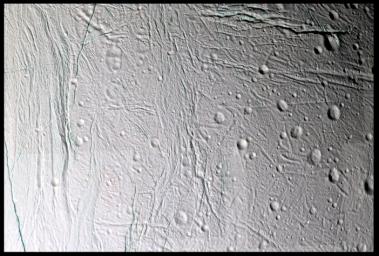Fine topographic detail and color variations are revealed in this 11-image, false color mosaic taken during Cassini's second close flyby of Saturn's moon Enceladus, on March 9, 2005.
This mosaic, a high-resolution cropped section of the full-disk mosaic available in PIA08354), shows the center of the anti-Saturnian hemisphere of Enceladus -- the side of Enceladus that always faces away from Saturn. The left portion of the mosaic is dominated by Diyar Planitia. Like Sarandib Planitia, observed in the previous Enceladus flyby of February 2005, the region is characterized by low ridges and troughs. Throughout this region, fractures of all sizes cut across Diyar Planitia and the older, cratered terrain at center and right.
Many of the younger fractures have blue-green walls, revealing coarse-grained water ice in the top layers of Enceladus' lithosphere, compared to the fine-grained ice that coats much of Enceladus' surface. The blue-green color is very similar to the coatings of the south polar "tiger stripes." The color here is greener than the features in the south polar mosaic released in 2005 (see PIA07800) due to the use of clear-filter images, instead of green, in the latter mosaic.
This mosaic consists of 11 false-color footprints (33 images total) taken by the Cassini spacecraft's narrow-angle camera. The mosaic uses an ultraviolet filter centered at 338 nanometers for blue, a green filter centered at 568 nanometers for green and a near-infrared filter centered at 930 nanometers for red, thus covering a wider spectrum region than the human eye. To create a single mosaic, the images were reprojected into an orthographic projection with a pixel scale of 45 meters per pixel. The region is centered at 3.9 degrees north latitude, 208.9 degrees west longitude and covers an area 233 kilometers (145 miles) by 154 kilometers (96 miles) in size.
The original images were taken by the Cassini spacecraft's narrow-angle camera from distances ranging from 4,300 to 27,050 kilometers (2,670 to 16,810 miles). The images have a phase, or sun-Enceladus-spacecraft, angle of 45 degrees. Image scale is 45 meters (150 feet) per pixel.
The Cassini-Huygens mission is a cooperative project of NASA, the European Space Agency and the Italian Space Agency. The Jet Propulsion Laboratory, a division of the California Institute of Technology in Pasadena, manages the mission for NASA's Science Mission Directorate, Washington, D.C. The Cassini orbiter and its two onboard cameras were designed, developed and assembled at JPL. The imaging operations center is based at the Space Science Institute in Boulder, Colo.
For more information about the Cassini-Huygens mission visit http://saturn.jpl.nasa.gov/home/index.cfm. The Cassini imaging team homepage is at http://ciclops.org.

 Planetary Data System
Planetary Data System












